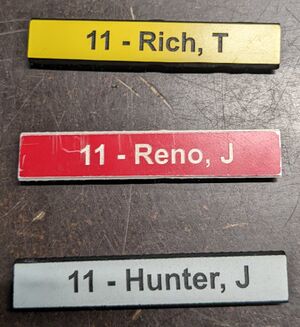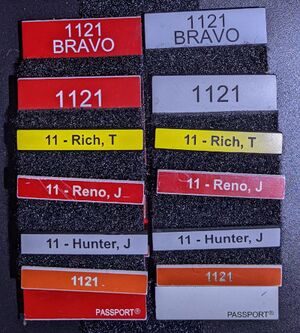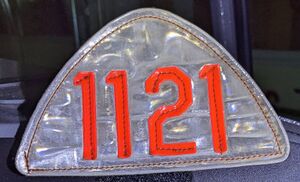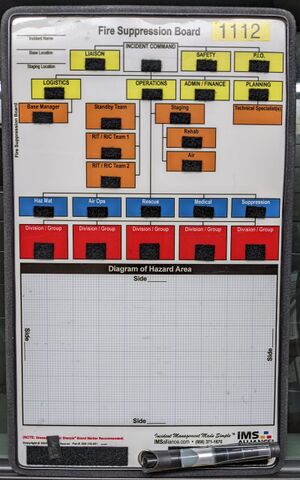Passport Accountability System
MEFD utilizes a Passport Accountability System (PAS) based on tags and passports. The same system is used by most if not all departments in the county.
Components
The system is built on two pieces: Tags and Passports
Tags:
Tags are simply small plastic rectangles with the firefighter's name on the front and velcro on the back. The color of the tag indicates rank: yellow for firefighters, red for officers, white for chiefs.
Each firefighter gets at least 5 tags. Two go on your structure helmet, two go on your wildland helmet. The remaining tag goes on the status board at your station.
Passports:
The passports are larger plastic rectangles with velcro and the apparatus number on their front.
There are two sets of passports attached to the dash of each apparatus. A primary set and a bravo set. The bravo set is used in the case that crews are to be split. Each set consists of a red passport and a white passport.
Using PAS:
Three groups use the PAS system. Each a little differently.
Firefighters:
As a firefighter all you have to do is provide your PAS tag to your officer as you enter the apparatus. Take and apply a helmet shield to your helmet. At the end of the call, remove your shield and retrieve your tags.
Get in the habit of passing up your tags every time you get in an apparatus.
Officers:
As an officer (or firefighter in the officer seat) you will tag in just like your crew. In addition you must collect two PAS tags from everyone on the apparatus and place one on a red passport and one on a white passport.
When you arrive on scene leave the red passport in the apparatus and bring the white passport to command. In the case where command and/or accountability are not set up yet, leave both passports on the dash where an IC can get them later.
(Helpful mnemonic: "white tags to the white hat (chief/command), red stays with the rig")
When you leave a scene remember to collect your crew's passport.
Incident Commander:
As an incident commander you will collect passports from all crews as they arrive on scene. You will use your command board to track their current location/task (staging, interior, rehab, etc).
This is where the accountability part really comes in. As IC you should be able to tell where all personnel are on the scene.
Note: On larger events (such as wildland fires) IC may not handle accountability directly, but will assign one or more reports to do so.
Strengths and Weaknesses
Strengths:
- No electronics, software, or batteries
- Can't really fail
- Portable
- Easy to use
- Widely used
Weaknesses:
- It requires firefighters to be compliant
- No tracking (position, times, etc)
- The velcro tends to fall off



